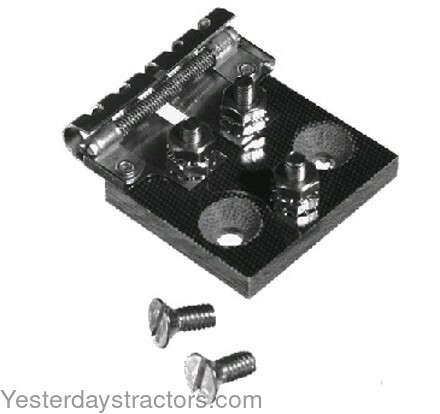OK -good fuel flow so your next step is to move on to electrical. You haven't said if you have the OEM Ballast Resistor in the circuit, all wired correctly as OEM. That'd be the first step. HFJ has posted a picture of the OEM Ballast Resistor. If you do not have it, that is the only new part you need to buy. I?d also say your coil is most likely good so leave it alone. Front Mount Distributor tune-ups scare a lot of folks, but the truth is they are not difficult to do at all and a good learning experience. Go to the other Ford N-series Tractor site, the *N* - *T* - *C* and look at the top menu bar for the HOW-TO's forum, under electrical. You will find documents on doing a tune-up and also "WIRING PICTOGRAMS BY JMOR". All are available for FREE to download to your own PC. Use the latter to verify your system is wired all correctly. A new 12V coil is best to eliminate not having to use an external resistor. Forget about all these VOM readings you keep mucking with. The funny thing about FM coils is they can check good static, about 1.3 OHMS, but in actual use as they get hot, can fail. You would need sophisticated, expensive test equipment to truly diagnose if good or bad. One major reason why they fail is if the key switch was left 'ON' and the points were closed. This can melt the insulating tar inside them. As they get hot, the windings can short out. As they cool, they form a insulating barrier until heated up again. It could be why yours runs OK one minute and not the next. The front mount distributor tune-up is a workbench or kitchen table project. You do not remove the hood, radiator, gas tank, or doglegs. Yes, it?s true if they are already off, it is a bit easier to do, but unless a rebuild is in progress, no need to remove for a basic tune-up. Here?s how I do it: First is to clean off the unit and area with a spray bottle of mineral spirits and an air gun. I get all the accumulated dirt, grease, and crud off the external area to make it easier to handle. Next is to loosen the generator and slip the fan belt up over the fan blade out of the way then gently let the genny down out of the way ?you do not need to remove the entire unit. Loosen the coil wire from the coil post. Remove the plug wires. You can mark/number them with a piece of masking tape ?it?s important to know which wire is which when plugged onto the cap. FIRING ORDER is 1, 2, 4, 3, rotation CCW viewed from the front. I always take the coil off by slipping the bail down and removing it from the unit. Some fellas leave it on, I find it easier to maneuver the unit to get it off without. Two bolts secure the unit to the front timing gear cover. They are 5/16-18 x 7/8 long hex head bolts and you need a ?? combination wrench to loosen and remove the bolts with. There are lockwashers under the heads too. Keep them handy and cleaned off before re-installing later. The cam on the front mount has an offset tang. So does the engine front timing gear off the crank. It is designed so once the points are set correctly, your timing is set too. There is no mucking around with a timing light. It is, however, very possible to get the unit mounted 180? off, despite what others may say. If that happens, the moment you crank the engine, it will try to self-align and end up busting the distributor base around the cam tang aluminum housing. Don?t let that scare you. When you go to mount the rebuilt unit, you will verify the engine tang position and align the distributor tang exactly in the same position. Best to use a good LED flashlight and inspection mirror to get a accurate visual. Also, have a buddy verify tang locations as well just to get a second set of eyes on it. I always install the coil at rebuild after new points and condenser are set and unit has passed testing. Mount the unit back on by hand gently, feeling for the tang to slip in correctly. Unit should be flush with front cover face. Insert bolts, snug up each side equally then tighten down. Install wiring as was removed then reset the generator and fan belt. If you don?t feel up to doing your own tune-up, send it to me and I can do it for you. I have a few rebuilt units all set to go too if you elect to just do an exchange. It is up to you to do the removal and installation. The OEM Ballast resistor is mounted on the LH rear dash panel, near the AMMETER but when viewed from the front of tractor is on the RH side. I?d use the 12V coil you have, it most likely is good. Remove the external ceramic 1-OHM resistor altogether per WIRING PICTOGRAMS, 12V setup. You can find distributor tune-up instructions in the original 8N Operator?s Manual and the I&T F-04 Manual. Do you have them? If not, you might want to get them. You are on the right track, just need some basic guidance. It?s a learning experience but not impossible. I guarantee you I can get, and so can anyone else, any non-starting N going regardless if 6V/POS GRN or 12V/NEG GRN with a simple distributor rebuild/tune-up and a correctly wired electrical system. I do this at least once a month for customers, and have done hundreds of tune-ups.
FORD EARLY 8N ORIGINAL DASH WIRING. BALLAST RESISTOR LOCATED AT 7 O?CLOCK POSTION OF AMMETER:
FORD OEM WIRING DIAGRAMS for reference:
Tim *PloughNman* Daley(MI)






